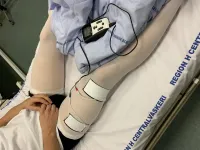Alzheimer's: Blood oxygen levels could explain why memory loss is an early symptom
2021-05-28
(Press-News.org) In a world first, scientists from the University of Sussex have recorded blood oxygen levels in the hippocampus and provided experimental proof for why the area, commonly referred to as 'the brain's memory centre', is vulnerable to damage and degeneration, a precursor to Alzheimer's disease.
To understand why this region is so sensitive, the University of Sussex researchers, headed up by Dr Catherine Hall from the School of Psychology and Sussex Neuroscience, studied brain activity and blood flow in the hippocampus of mice. The researchers then used simulations to predict that the amount of oxygen supplied to hippocampal neurons furthest from blood vessels is only just enough for the cells to keep working normally.
Dr Catherine Hall, Senior Lecturer in Psychology at the University of Sussex says:
"These findings are an important step in the search for preventative measures and treatments for Alzheimer's, because they suggest that increasing blood flow in the hippocampus might be really effective at preventing damage from happening.
"If it's right that increasing blood flow in the hippocampus is important in protecting the brain from diseases like Alzheimer's, then it will throw further weight behind the importance of regular exercise and a low-cholesterol diet to long-term brain health.
"We think that the hippocampus exists at a watershed. It's just about OK normally, but when anything else happens to decrease brain blood flow, oxygen levels in the hippocampus reduce to levels that stop neurons working. We think that's probably why Alzheimer's disease first causes memory problems - because the early decrease in blood flow stops the hippocampus from working properly.
"The same factors that put you at risk of having a heart attack make you more likely to develop dementia. That's because our brains need enough blood flow to provide energy - in the form of oxygen and glucose - so brain cells can work properly, and because blood flow can clear away waste products such as the beta amyloid proteins that build up in Alzheimer's disease.
"Now we want to discover whether the lower blood flow and oxygen levels in the hippocampus are what causes beta amyloid to start to build up in Alzheimer's disease. Understanding what causes early damage will be really important to help us learn how to treat or prevent disease."
Dr Kira Shaw, a psychology researcher at the University of Sussex who undertook the main experiments, reported:
"We found that blood flow and oxygen levels in the hippocampus were lower than those in the visual cortex. Also, when neurons are active, there is a large increase in blood flow and oxygen levels in the visual cortex. This provides energy to hungry neurons. But in the hippocampus, these responses were much smaller."
The scientists also found that blood vessels in the hippocampus contained fewer mRNA transcripts (codes for making proteins) for proteins that shape blood vessel dilation. Additionally, the cells that dilate small blood vessels, called pericytes, were a different shape in the hippocampus than in the visual cortex.
Dr Shaw concluded: "We think blood vessels in the hippocampus are less able to dilate than in the visual cortex".
INFORMATION:
The full research paper, 'Neurovascular coupling and oxygenation are decreased in hippocampus compared to neocortex because of microvascular differences' is published in Nature Communications. This research was funded by the Medical Research Council, the Academy of Medical Sciences, and the Wellcome Trust.
ELSE PRESS RELEASES FROM THIS DATE:
2021-05-28
The basis for this new take on the classification was laid in 1985, when John Long attributed a fossil tooth plate to a new species, Edaphodon eyrensis. The species was named after Lake Eyre, near which the tooth was found in 1978.
Asscoiate Professor Evgeny Popov had his doubts about the attribution. However, he had to study the fossil personally to advance his theory. The opportunity presented itself during a trip to Australia in 2010. The tooth plate was stored in a museum in Adelaide, South Australia.
"I didn't plan to go there, but I was able to negotiate a temporary ...
2021-05-28
A research group from Aarhus University has developed a special biocompatible electrode for electrical muscle stimulation that the group has integrated and 3D-printed onto medical support stockings.
In the winter 2020/2021, the stockings were tested on hospitalised Covid patients. The studies were completed in March, but apart from a case study (Danish Medical Journal) data have not yet been published. However, the project group reveal that the results are very promising.
The stockings were tested on 16 Covid-19 patients who agreed to try the support stocking during their hospitalisation. The participants were hospitalised for five to seven days and were given a support stocking on each leg, but only ...
2021-05-28
The countries around the Baltic Sea do not respect their binding international agreement to reduce agricultural pollution of the marine environment. Despite farming activities being the single most important source of nutrient pollution to the Baltic Sea.
An international research team presents evidence on these circumstances in a recent scientific article in the journal Ambio, published by the Royal Swedish Academy of Sciences.
The countries made a commitment 20 years ago to implement 10 specific reduction measures in their national legislation on agricultural pollution - e.g. featuring minimum storage capacity for manure and regulations on animal densities.
Now the researchers' study of legislations and regulations in place at national level, to address ...
2021-05-28
AMES, Iowa - Researchers have developed new types of materials that combines two or three types of nanoparticles into structures that display fundamental new properties such as superfluorescence.
"The whole goal of this research is to make new materials with new properties and/or exotic new structures," said Alex Travesset, an Iowa State University professor of physics and astronomy and an associate scientist for the U.S. Department of Energy's Ames Laboratory. "Those materials are made of very tiny materials, nanoparticles, and lead to properties not shared by more traditional materials made of atoms and molecules."
In this case, an international research team is combining perovskite nanocubes - tiny crystals with useful electrical or optical properties ...
2021-05-28
Metal-organic framework compounds (MOFs) consist of inorganic and organic groups and are characterised by a large number of pores into which other molecules can be incorporated. MOFs are therefore interesting for many applications, for example for the storage of gases, but also for substance separation, sensor technology or catalysis. Some of these MOF structures react to different guest molecules by changing their structures. They are thus considered switchable.
One of these is "DUT-8", a material that has now been studied at the MX beamlines of BESSY II. "MOF crystals can be analysed very well at the MX beamlines," says HZB expert Dr. Manfred Weiss, who heads the MX team. ...
2021-05-28
A breast cancer therapy that requires just one shot of radiotherapy is as effective as traditional radiotherapy, and avoids potential damage to nearby organs, according to a paper by UCL experts.
The results, published in the British Journal of Cancer, mean that eight out of ten patients who receive the treatment, TARGIT-IORT, will not need a long course of post-operative external beam radiotherapy (EBRT). These results strengthen and expand previously published outcomes.
Patients who received the treatment are less likely to go on to experience fatal cardiovascular disease such as heart attacks, lung problems or other cancers. As well as avoiding scattered radiation from EBRT that can damage nearby vital organs, delivering TARGIT-IORT during the lumpectomy procedure seems to ...
2021-05-28
Much of human invention and innovation has been the result of our discovery and replication of natural phenomena, from birds serving to inspire human flight, to whales allowing us to dive deep into the ocean with submarines. For the first time ever, researchers have captured at the nanometer level the gliding machinery of the bacterium Mycoplasma mobile. Their findings were published in mBio. This brings us closer to understanding the origin and operating principle of motility, which could serve as a basis for the next generation of nanoscale devices and pharmaceuticals.
"My lab has been studying the molecular nature of bacteria from the Mycoplasma genus for years", ...
2021-05-28
(Bethesda, MD - May 25, 2021) A new study published in Nature Scientific Reports has found that Methylene Blue, a century old medicine, has the potential to be a highly effective, broad-spectrum UV irradiation protector that absorbs UVA and UVB, repairs ROS and UV irradiation induced DNA damages, and is safe for coral reefs. The study suggests that Methylene Blue could become an alternative sunscreen ingredient that supports the environment and protects human skin health.80% of today's sunscreens use Oxybenzone as a chemical UV blocker, despite multiple studies that have shown it expedites the destruction of coral reefs. Several states and countries have now banned the use of Oxybenzone and its derivatives to stop the devastating ...
2021-05-28
Viruses are perfect molecular machines. Their only goal is to insert their genetic material into healthy cells and thus multiply. With deadly precision, they thereby can cause diseases that cost millions of lives and keep the world on edge. One example for such a virus, although currently less discussed, is HIV that causes the ongoing global AIDS-epidemic. Despite the progress made in recent years, 690 000 people died in 2019 alone as a result of the virus infection. "If you want to know the enemy, you have to know all its friends," says Martin Obr, postdoc at the Schur group at IST Austria. Together with his colleagues, he therefore studies a virus belonging to the same ...
2021-05-28
A new study exploits the characteristic epigenetic signatures of childhood tumors to detect, classify and monitor the disease. The scientists analyzed short fragments of tumor DNA that are circulating in the blood. These "liquid biopsy" analyses exploit the unique epigenetic landscape of bone tumors and do not depend on any genetic alterations, which are rare in childhood cancers. This approach promises to improve personalized diagnostics and, possibly, future therapies of childhood tumors such as Ewing sarcoma. The study has been published in Nature Communications.
A study led by scientists from St. Anna Children's Cancer Research Institute (St. Anna CCRI) in collaboration with CeMM Research Center for Molecular Medicine of the Austrian Academy of Sciences provides an innovative ...
LAST 30 PRESS RELEASES:
[Press-News.org] Alzheimer's: Blood oxygen levels could explain why memory loss is an early symptom


